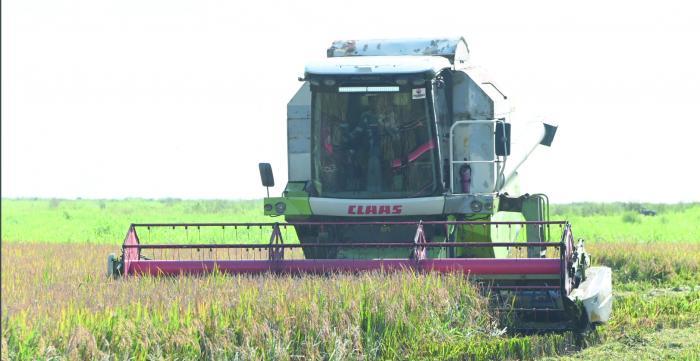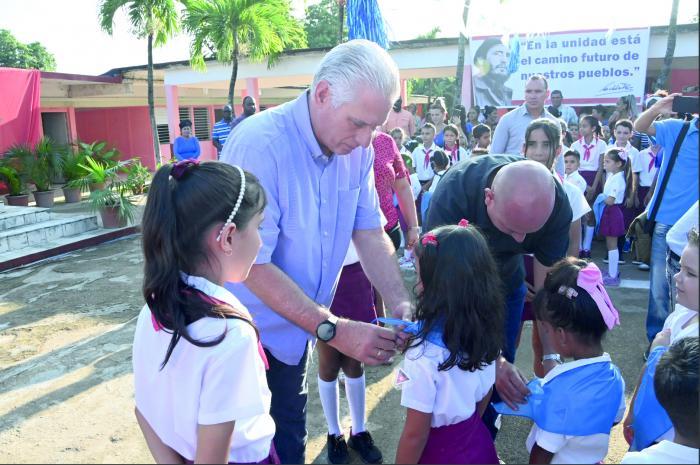There is a moment of exceptional significance for every Cuban family, and that is when it is time to put their child in uniform and get them ready to arrive at school looking impeccable. No matter how many difficulties there are, no matter how many things are missing, all the children on the island will arrive eagerly anticipating meeting their classmates and teachers.
This October 8 was no different, and it could be said that it had special meaning in every schoolyard, because it commemorated another anniversary of the fall of the Heroic Guerrilla, and every girl and boy in first grade received their blue scarf, that of the Moncadista Pioneer.
That is why yesterday morning it was a pleasure to see the Antonio Maceo primary school in the municipality of Chambas, in the province of Ciego de Ávila, which was visited by the President of the Republic of Cuba, Miguel Díaz-Canel Bermúdez, accompanied by the member of the Political Bureau and secretary of Organization of the Party's Central Committee, Roberto Morales Ojeda, as well as local authorities, as part of what has become a working style: traveling around the country to learn firsthand about the functioning of various experiences.
With an enrollment of 641 students, the school's undisputed strength is its 100% teacher coverage. This was proudly explained to reporters by the principal, Minerva de la Caridad Rodríguez Escobar, who highlighted the school's academic results.
On a morning when children, parents, and teachers gathered to tie scarves around the necks of 88 pioneers, President Díaz-Canel Bermúdez placed the blue symbol on the shoulders of a girl; and in that gesture, repeated thousands of times, by thousands of parents in unison, on a day that returns year after year, laden with symbolism.
EFFORTS THAT YIELD RESULTS
The next stop on the itinerary was the Nguyen Van Troi Sand Production Plant, belonging to the Canteras Chambas Base Business Unit (UEB). There, Asdrúbal Pérez, director of the entity, explained to the Head of State that the production of processed sand, artificial sand, granite, and river gravel is destined for the installation of photovoltaic parks, housing construction, and other investments such as those made in the tourism sector.
The dignitary wanted to know details about the stability of the workforce, the benefits that workers receive, and the use of science and innovation. "How do you maintain the flow of production amid the complex energy situation?" asked the Head of State, to which they explained that the solution has been to create working groups that spring into action depending on the availability of electricity.
The next stop on the tour was the El Tesoro farm, located near the community of La Oriental and owned by the Chambas agro-industrial company. The farm has a total area of 6,500 hectares, of which 5,068 are used for rice production.
The results there are encouraging: the spring campaign closed at 103% of the target. That is why producer Alexei Marrero assured the president that there is no problem that would prevent them from meeting their goals. "We want to become self-sufficient in the shortest time possible," said Díaz-Canel Bermúdez. He meant that they would not have to import rice, and the money that would be invested could then be used to purchase the supplies that agriculture needs.
Díaz-Canel showed particular interest in knowing whether the company has self-consumption and whether bioproducts are being used in rice cultivation. He also wanted to know whether, with the production they have, workers can improve their lives. "If there is rice, let them earn," he reasoned, alluding to the right of those who work hard and achieve results to prosper.
ENCOURAGING PASSAGES IN THE MUNICIPALITY OF CIRO REDONDO
The country's leadership also visited the municipality of Ciro Redondo in the province of Ciego de Ávila. There, the first stop was a small factory located on the La Candelaria farm, which belongs to the Patricio Sierralta Credit and Services Cooperative (CCS).
This facility produces preserves made from coconut, guava, tamarind, cherry, and cashew. On Wednesday, small and large containers of lemon juice, mango pulp, and shredded coconut were on display.
The President learned about the entity's connection to knowledge derived from science and technology. In the mini-industry, for example, the studies undertaken by Miguel Ángel Iparraguirre, PhD in Science, who is engaged in obtaining a high-quality biofertilizer, are of great value.
Another item on the agenda was the Pina collection center, part of the Majagua Production Base Business Unit (UEB), where light oil is extracted, mainly for the production of diesel fuel, dielectric oil for transformers, and asphalt. There, the country's leadership was briefed on the production process and the material limitations that affect hydrocarbon extraction.
The Head of State asked about wages, whether they have self-consumption—the answer was yes—and whether the workforce is stable in this activity, which is undoubtedly important for the country's development.

GOOD SIGNS IN JATIBONICO
In the afternoon, in the municipality of Jatibonico, in the province of Sancti Spíritus, President Díaz-Canel visited the La Belkys Farm, belonging to the Argelio Calderón Basic Cooperative Production Unit (UBPC) of the Uruguay Sugar Agroindustrial Company.
Producer Osmany González Luzardo explained to the country's leadership that they have 50 hectares planted with beans, onions, peanuts, and sweet potatoes. These efforts are aimed at industry and priority centers in the territory, which have a social impact.
Despite the limitations imposed by the complex energy situation, the essential objective of the workers is to continue increasing production as much as possible. From the field, President Díaz-Canel said to those who have worked hard with remarkable results: "There is a tremendous work culture here. Look at the plantations..."
The other stop on the tour was a sugarcane field, also belonging to the Argelio Calderón UBPC. There, they explained to the president their strategy for continuing to expand this type of crop. Speaking to workers and managers, the head of state emphasized the importance of diversifying production, always keeping in mind the need to grow as much food as possible.
Next, the visit moved on to the machinery workshop, which also belongs to the Uruguay Company. The First Secretary of the Central Committee of the Communist Party of Cuba was able to observe the equipment available for ensuring the sugar harvest and other agricultural activities.
The company's corporate purpose, as explained to the Head of State, is to manufacture and repair parts to meet the production challenges of the company.
On October 8, the country's leadership began the day at a school, placing blue scarves on the youngest pioneers. And it is no coincidence that it continued with scenes such as the land, which contributes so much to well-being: Che Guevara would have been doing the same or something similar if he were on the island; he would have been inspecting furrows, factories, collectives of peasants and workers; he would have been fighting for a stronger and more humane Cuba.
















